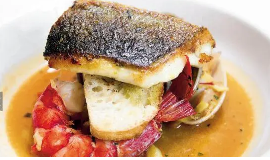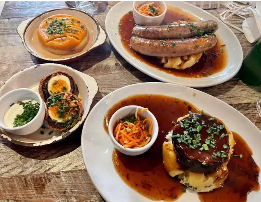The food of all countries to defend the tongue culture of the six countries into the heritage of food culture
5 min read
When it comes to food, every foodie can be proud of their country’s long-standing food culture. Today, let’s take a look at it French dinner.In November 2010, French food culture was the first to be listed as a world intangible cultural heritage. The French feast is described by UNESCO experts as “a social custom used to celebrate the most important moments in the life of an individual or group”. As a world famous country of food culture, different regions of France have different characteristics of food. Its relatively characteristic food are: frog legs, stewed chicken, French snails, the staple food is mainly with French characteristics of croissants and baguettes. Because the French people attach great importance to food, so French restaurants are famous for their luxurious etiquette and flavor, the most luxurious and expensive restaurants in the world’s major cities are almost all French restaurants.
Mediterranean diet On November 17, 2010, UNESCO listed the Mediterranean diet among the intangible cultural heritage jointly owned by Spain, Greece, Italy and Morocco, affirming that it is not only an important historical and cultural product of these countries, but also a great contribution to world civilization. The diet of southern European countries along the Mediterranean is dominated by fruits and vegetables, fish, whole grains, beans and olive oil. Studies have found that the Mediterranean diet reduces the risk of heart disease. It also protects the brain from blood vessel damage and reduces the risk of stroke and memory loss. The term “Mediterranean diet” also refers to a healthy, simple, light and nutrient-rich diet.
Washoku On December 5, 2013, “Washoku Japanese Traditional Food Culture” submitted by Japan was officially listed as a World Heritage site. Washoku originated from the Japanese islands and gradually developed into a unique Japanese cuisine. “Washoku” requires natural color, delicious taste, diverse shape, good utensives. Moreover, the material and conditioning method attaches importance to the sense of seasons. The Japanese government proposed Washoku as a world heritage site in the belief that it reflects the Japanese spirit of “respecting nature” and is a “social custom” related to food. The specific content is: Japanese cuisine keeps the fresh and original ingredients, and pays attention to diversity; The pursuit of balanced nutrition is a healthy way of eating; Reflects the unique lifestyle, the beauty of nature and the changes of solar terms, and is closely related to traditional festival activities.
Korean winter kimchi.
In March last year, the Korean government submitted an application to UNESCO for the intangible cultural heritage of Kimchi and Kimchi Culture, which was approved in December last year. The Korean culture of making winter kimchi has been passed down from generation to generation, and the spirit of neighborhood sharing has been promoted. This culture has strengthened the sense of bond, identity and belonging among Koreans.
Build a Museum of American Food.
Various themes show historical crafts.
Many countries choose to build museums dedicated to food, including beer, chocolate, pasta, bread, seafood and other diverse themes to celebrate traditional food culture.
Seoul opened a kimchi Museum in 1986. The museum is divided into galleries based on the history, types, production, preservation methods, and efficacy of pickled vegetables. It displays documents on the evolution of pickled vegetables, archaeological relics, paintings, paintings and containers that witnessed the process of making pickled vegetables, and holds regular lectures on various kimchi topics.
The Museum of Pasta in Rome, Italy, has 11 galleries dedicated to the world’s greatest Italian invention. The exhibits trace the history of flour, show how pasta is made, and visitors can even see how artists paint with pasta.
Currywurst is Germany’s most famous and proud street food. Berlin’s currywurst Museum showcases the history of currywurst, its legendary ingredients and spices, as well as its appearance on television and in movies. Of course, you can also go to the tapas restaurant to taste the delicious currywurst.
Belgium has the first French Fries museum in the world; All the items on display are related to French fries. The museum introduces visitors to the history of the potato, shows how French fries are made, and finally, visitors can eat delicious French fries here.
Sustainable Seafood Campaign.
Delicious seafood is an integral part of a French meal and is sought after by food lovers around the world. However, multiple studies have reported that the ocean’s major fish species could be gone by 2050 due to overfishing by humans. Since 2011, a “sustainable seafood movement” has been taking place in several European countries, including France. A number of top chefs have come up with a response designed to cure the disease by removing endangered fish from their menus and replacing them with other seafood.
The Sustainable Seafood movement has been echoed by many Michelin-starred restaurants, which prefer “sustainable” seafood in larger quantities when selecting ingredients, and by restaurateurs and chefs who actively promote the concept of “sustainable consumption” of seafood to fishermen, fishmongers, foodies and restaurant guests alike. With the Sustainable Seafood movement gaining traction, sustainability is no longer limited to seafood, but also includes all kinds of ingredients such as meat and vegetables.
Legislate against fast food culture.
A 2013 survey by the French Restaurant and Hotel Trade Union found that 31 percent of French restaurants served food that had been heated and prepared, rather than cooked at home. To ensure the quality of food, the union proposed that only those restaurants that cooked in their own kitchens should be called “restaurants”. That would discourage restaurants that order food from factories or simply microwave cooked food before serving it.
However, the bill failed to pass parliament because it was too draconian. But a relatively compromise bill was passed: restaurants must label which dishes are homemade and which are processed.
Eu Prepares’ Official Menu ‘.
In 2013, the European Union launched a project called the European Food Information Resource Network, which aims to bring together the most authoritative recipes and nutritional information for various ingredients in EU member states. The network covers the most traditional dishes of each EU member state, and features the most local cooking methods, as well as cooking tips handed down from generation to generation, reflecting the traditional food culture of the region.
Japan wanted to send ‘Sushi Police’.
In 2006, the Japanese government appointed a panel of food experts to discuss the standards and details of a global certification system for Japanese restaurants and to set up a set of standards for certifying Japanese restaurants overseas, with the aim of cleaning up restaurants that claim to be Japanese but use ingredients and cooking techniques that are completely different from the real thing. After the plan was announced, restaurateurs at home and abroad blasted it as ridiculous, unrealistic and discriminatory for Japan to go around the world pointing fingers. Under pressure, Japan’s Ministry of Agriculture, Forestry and Fisheries has finally scrapped plans for the “sushi police”. The training system for sushi chefs in Japan is really strict. Professional sushi chefs usually spend at least 10 years in school.






